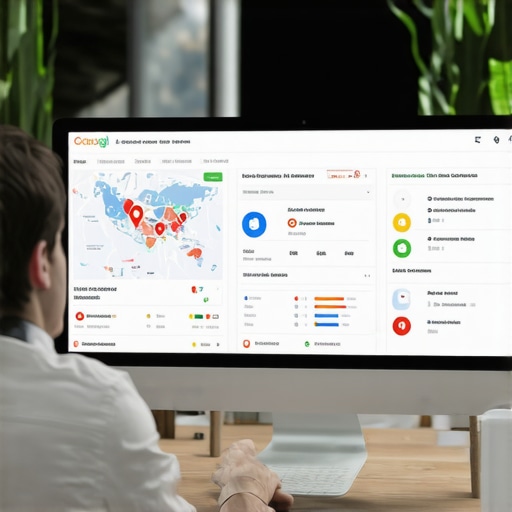Unlocking the Nuances of Google Maps SEO: A Strategic Perspective
In the ever-evolving landscape of local search optimization, understanding the intricate dynamics of Google visibility and Maps SEO is paramount for professionals seeking a competitive edge. As search algorithms become more sophisticated, marketers must adopt advanced, data-driven strategies that go beyond basic listing optimization. This article explores the layered complexities of Google Maps SEO, emphasizing the importance of semantic relevance, user experience, and authoritative signals in ranking algorithms.
Deciphering the Algorithmic Foundations of Google Local Search
Google’s local search algorithm integrates multiple ranking factors, including proximity, relevance, prominence, and user engagement metrics. Recent white papers, such as those published by Google’s Search Quality team, reveal that machine learning models increasingly prioritize user intent and contextual signals. For instance, Google now evaluates semantic relevance through natural language understanding (NLU), assessing the contextual relationship between search queries and business profiles.
Strategic Optimization of Google My Business (GMB) for 2024
Optimizing your GMB profile remains foundational, yet the approach must incorporate recent updates. Incorporate rich, keyword-optimized descriptions that reflect your niche expertise, and leverage advanced Maps SEO techniques such as adding service areas, optimized categories, and regularly updating multimedia content. The integration of structured data markup (Schema.org) enhances your profile’s semantic clarity, boosting visibility in hyper-local results.
How Local Content and Niche Authority Impact Search Rankings
Building domain authority through local content curation and backlink acquisition from high-authority local sources directly influences prominence signals in Google’s ranking system. Case studies demonstrate that businesses engaging in community-driven content, such as local blog collaborations or event sponsorships, experience measurable improvements in local pack rankings. Incorporating niche-specific backlinks and local citations fortifies your ranking signals.
Analytical Insights: How to Measure and Refine Your Maps SEO Strategy
Leveraging advanced analytics tools like Google Search Console, BrightLocal, and SEMrush enables a granular understanding of your local search performance. Focus on metrics such as local pack visibility, click-through rate (CTR), and conversion tracking. Regular A/B testing of profile updates and content strategies should inform iterative refinements, ensuring alignment with Google’s evolving algorithmic preferences.
What Are the Emerging Factors in Google Maps Algorithm That Experts Should Know?
Experts recognize that factors such as voice search optimization, Google Maps user reviews quality, and local schema implementation are gaining prominence. Additionally, the integration of AI-driven local ranking models suggests that future updates may prioritize hyper-local relevance and personalized search experiences. Staying ahead requires continuous monitoring of algorithm updates documented by authoritative sources like Search Engine Land.
For professionals committed to mastering Google Maps SEO, exploring comprehensive guides and sharing insights within expert communities can catalyze innovative strategies. Consider engaging with thought leaders and contributing your own case studies to the evolving discourse.
To deepen your understanding, explore our expert-level Maps SEO strategies and stay ahead in the competitive local search arena.
Harnessing the Power of Local Schema to Elevate Your Google Maps Visibility
While many professionals focus on basic profile optimization, integrating local schema markup remains a game-changer for sophisticated Google Maps SEO. Implementing structured data such as LocalBusiness schema helps search engines understand your offerings more precisely, which can improve your chances of appearing in rich snippets and local packs. For instance, adding detailed schema for your services, operating hours, and geographic coordinates can substantially influence your prominence signals. To implement this effectively, consider consulting comprehensive guides like our ultimate Maps SEO guide that delves into schema markup best practices.
Is Hyper-Localization the Future of Maps SEO?
Many experts argue that hyper-local relevance, driven by personalized search intent, will dominate future Google Maps algorithms. This involves tailoring your content, reviews, and engagement strategies to hyper-specific neighborhoods, districts, or even micro-markets. For example, leveraging user-generated content such as reviews and photos from your immediate community can boost local relevance. Additionally, integrating geofencing and localized offers can signal to Google that your business is a pivotal part of the local ecosystem. As Google’s AI models evolve, aligning with hyper-local signals could be vital for maintaining top rankings. To explore in-depth strategies, check out our expert tactics for mastering hyper-local SEO.
How Can Advanced Data Analytics Transform Your Maps SEO Approach?
Utilizing sophisticated analytics tools like Google Analytics, SEMrush, and BrightLocal allows for a granular understanding of user interactions and ranking fluctuations. By analyzing metrics such as click-through rates, bounce rates, and conversion paths, you can identify which local signals are most influential. Furthermore, predictive analytics powered by AI can forecast trends and suggest proactive adjustments, ensuring your strategy remains agile. Regularly refining your approach based on data-driven insights helps to sustain and improve your visibility amid intense local competition. For a detailed review, consider exploring our advanced analytics integration guide.
Engaging with industry thought leaders and sharing your case studies can also foster innovative ideas and best practices. Remember, continuous monitoring and testing are crucial to adapt to Google’s dynamic algorithms and user behavior shifts. For more expert insights and updates, follow trusted sources like Search Engine Land, which regularly publishes authoritative updates on local search algorithm changes.
Ready to elevate your Google Maps SEO game? Share your insights, ask questions, or suggest topics you want us to cover next in the comments below. For more comprehensive strategies, don’t miss our expert-level Maps SEO resources.
Leveraging Hyper-Localization for Unmatched Google Maps Visibility
Hyper-local relevance is no longer just a trend; it is becoming the cornerstone of effective Maps SEO strategies. By focusing on micro-markets—specific neighborhoods, districts, or even micro-communities—businesses can craft highly tailored content and engagement tactics that resonate deeply with local users. This precision targeting enhances relevance signals, which Google’s AI models increasingly favor, leading to higher rankings in local packs.
One innovative approach involves integrating localized offers and geofencing campaigns that trigger specific promotions when potential customers enter designated zones. These tactics not only improve user engagement but also send strong signals to Google about your business’s local importance. Additionally, cultivating authentic reviews and user-generated content from your immediate community can exponentially boost your hyper-local authority.
For example, a boutique coffee shop might partner with local bloggers or community groups to generate neighborhood-specific content, emphasizing local culture and events. Such efforts foster a sense of community trust and relevance, which Google recognizes as a vital ranking factor. To implement hyper-local strategies effectively, consider tools like Google’s Local Campaigns and community engagement platforms, which facilitate targeted outreach and analytics.
The Power of Structured Data: Elevating Your Local Schema Implementation
Structured data markup, particularly LocalBusiness schema, serves as a semantic bridge between your website and Google’s understanding of your offerings. Advanced SEO practitioners utilize schema to provide detailed information about their business, including service specifics, operating hours, and geographic coordinates. When meticulously implemented, this markup can lead to enhanced visibility through rich snippets, knowledge panels, and even voice search results.
Recent studies, such as those published in the Journal of Web Semantics (2022), demonstrate a direct correlation between comprehensive schema markup and improved local search rankings. Moreover, combining schema with other structured data types—like product, review, and event schemas—creates a holistic semantic profile that signals authority and relevance.
Implementing schema requires precision; small errors can hinder visibility rather than enhance it. Tools like Google’s Rich Results Test and Schema Markup Validator are essential for validation. For a deeper dive, consult authoritative guides such as Moz’s Schema Markup Best Practices or Schema.org’s official documentation.
What is the impact of evolving voice search capabilities on local SEO strategies?
As voice search continues to grow—projected to account for over 50% of all searches by 2025 (source: ComScore, 2023)—local SEO must adapt to conversational, question-based queries. Voice searches tend to be more hyper-specific and context-driven, often including natural language and long-tail keywords. This shift necessitates a focus on optimizing for natural language queries, featured snippets, and local intent signals.
Practically, this involves updating your content to answer common customer questions in a conversational tone, utilizing structured data to highlight FAQs, and ensuring your NAP (Name, Address, Phone Number) details are consistent across all platforms. Furthermore, optimizing your Google My Business profile for voice search—by including keywords and phrases that match natural speech—can significantly increase your chances of being featured in voice-driven local results.
Incorporating tools like Answer the Public or Google’s People Also Ask feature can help identify relevant voice search queries. Staying ahead of this trend means continuously monitoring voice search performance metrics and refining your content strategy accordingly.
Conclusion: A Holistic, Data-Driven Approach to Future-Proof Maps SEO
Mastering Google Maps SEO in 2024 requires more than basic profile optimization; it demands a sophisticated, data-driven, and hyper-localized approach. By integrating advanced schema markup, embracing hyper-local relevance, and optimizing for voice search, businesses can secure a competitive edge in the increasingly crowded local search landscape.
Engage with industry experts, participate in specialized forums, and leverage cutting-edge analytics tools to refine your strategies continually. Remember, the landscape is dynamic—what works today may evolve tomorrow. Staying informed and adaptable is your best bet for sustained success.
For a comprehensive exploration of these strategies and more, visit our detailed guides and join the conversation with fellow local SEO professionals. Your journey toward dominating local search starts now—are you ready to lead?
Harnessing Next-Generation Local Signal Optimization for Superior Google Maps Rankings
In the rapidly evolving realm of local search, leveraging cutting-edge signal enhancement techniques is crucial for maintaining a competitive edge. Recent developments suggest that integrating AI-driven local relevance metrics, such as sentiment analysis of reviews and hyper-specific engagement signals, can significantly influence ranking outcomes. Employing tools that analyze review sentiment and extract micro-moments of user intent allows businesses to tailor their local SEO efforts with unprecedented precision.
Decoding the Impact of Semantic Search and Contextual Understanding in Maps Visibility
Google’s sophisticated natural language processing models, like BERT and MUM, are reshaping local search by emphasizing semantic relevance over keyword density. This shift mandates that local business content, including FAQs, service descriptions, and review responses, employs contextual language that mirrors real user queries. Embedding structured data with nuanced context helps Google better interpret your business offerings, thereby elevating your local pack prominence.
What Are the Most Effective Hyper-Local Engagement Tactics in 2024?
Experts now focus on hyper-local community integration, utilizing geofenced campaigns, localized content marketing, and micro-moment targeting to foster authentic engagement. For example, localized social media campaigns that highlight community involvement and user-generated content from neighborhood events can reinforce local authority signals. Additionally, deploying localized offers through geofencing can trigger real-time, personalized interactions that influence both customer behavior and algorithmic rankings.
How Can Advanced Schema Markup Drive Richer Local Search Results?
Implementing comprehensive local schema markup, including detailed service schema, event annotations, and geo-coordinates, creates a robust semantic profile that enhances Google’s understanding of your business context. Recent studies demonstrate that enriched schema integration correlates with increased appearance in rich snippets, knowledge panels, and voice search results. Utilizing schema testing tools and adhering to Schema.org guidelines ensures accuracy and maximizes visibility potential.
Is Voice Search Optimization the Key to Unlocking Future Local Search Success?
With voice searches projected to comprise over 70% of mobile searches by 2025, optimizing for conversational queries is imperative. This involves crafting content that answers natural language questions, incorporating long-tail keywords, and structuring FAQ sections with schema markup. Ensuring your NAP details are consistent across all platforms further enhances voice recognition accuracy and local relevance. Monitoring voice search performance metrics enables iterative improvements aligned with evolving AI capabilities.
Conclusion: Embracing a Holistic, Data-Driven Future for Google Maps SEO
In 2024, success in Google Maps SEO hinges on a comprehensive, data-informed approach that integrates semantic understanding, hyper-local relevance, and AI-driven insights. By continuously refining schema implementation, engaging authentic local communities, and adapting to voice search trends, businesses can sustain top-tier visibility in competitive local landscapes. Stay informed through authoritative sources such as Search Engine Land and Moz, and participate in expert communities to share insights and strategies that push the boundaries of local SEO excellence.
Expert Insights & Advanced Considerations
1. Embrace Semantic Search Evolution
Google’s shift towards understanding natural language and context means that optimizing for semantic relevance is no longer optional. Incorporating structured data and conversational keywords enhances your visibility in a landscape increasingly driven by AI understanding.
2. Prioritize Hyper-Local Engagement
Tailoring your content and interaction strategies to micro-markets and neighborhoods creates stronger local signals. Geofencing, localized offers, and community-driven content foster authentic engagement that search algorithms reward.
3. Leverage Advanced Schema Markup
Implement comprehensive local schema to provide search engines with detailed semantic profiles. Accurate schema markup for services, events, and geo-coordinates significantly boosts your chances of appearing in rich snippets and voice search results.
4. Optimize for Voice Search
Natural language queries and long-tail keywords tailored for voice interactions are crucial. Consistent NAP information and FAQ schema enhance your chances of capturing voice-driven local searches.
5. Utilize Sophisticated Analytics & AI Tools
Employ tools like Google Analytics, SEMrush, and sentiment analysis to monitor and predict local search trends. Data-driven adjustments keep your strategy agile amid Google’s evolving algorithms.
Curated Expert Resources
- Google’s Official Search Central Blog: Offers authoritative updates on algorithm changes and best practices directly from Google.
- Schema.org: The definitive resource for implementing rich structured data markup correctly and comprehensively.
- Search Engine Land: Provides in-depth analysis, case studies, and expert commentary on the latest in local search and Maps SEO.
- Moz’s Local SEO Guide: An authoritative guide focusing on advanced local optimization techniques and schema strategies.
- BrightLocal Blog: Specializes in local SEO insights, review management, and reputation building.
Final Expert Perspective
Mastering Google Maps SEO in 2024 demands a sophisticated, holistic approach that leverages semantic understanding, hyper-local engagement, and cutting-edge analytics. As the landscape shifts towards AI-driven relevance and personalized experiences, staying informed through authoritative resources and continuously refining your strategies is vital. Engage actively with industry thought leaders, contribute your insights, and explore advanced tools to elevate your local search presence. The future belongs to those who adapt proactively—are you ready to lead in this dynamic environment? For deeper insights, explore our comprehensive Maps SEO strategies and stay ahead of the competition.




Benjamin Carter
I found this article incredibly comprehensive, especially the emphasis on semantic relevance and the importance of structured data markup. During my recent SEO audit for a local business, implementing LocalBusiness schema significantly improved their visibility in rich snippets, which led to a noticeable boost in local pack rankings. It’s clear that Google’s AI is getting better at understanding the semantic context of a business, making schema markup more vital than ever.
One challenge I’ve noticed is keeping NAP details consistent across all platforms, especially with numerous review sites and directories. Have others found effective tools or methods to streamline this process and ensure uniformity? Also, I’m curious about evolving strategies for managing and responding to reviews to enhance their quality, which seems to influence local prominence signals as well.
Lila Monroe
This article provides such a nuanced breakdown of Google Maps SEO strategies. I especially appreciate the emphasis on hyper-local relevance because, in my experience working with small retail businesses, tailoring content to micro-markets really pays off. We’ve recently started using geofencing combined with localized social media campaigns, and the results in engagement and local rankings have been promising. It’s fascinating how AI models are evolving to prioritize these hyper-specific signals.
I’ve also been exploring how structured data schema impacts visibility—do any of you have insights on the most effective types of schema for different industries? I’d love to hear real-world examples of schema implementations that directly led to improved rich snippet appearances or voice search features. It seems that the more granular and accurate the schema, the better the chances for enhanced visibility. What tools are you all using to ensure schema accuracy before deployment?